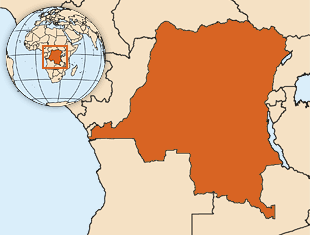  PROGRAMS & THEMES: Gender, IFIs and Gender-Based Violence

Case Study:
Democratic Republic of Congo
Download the case study (pdf, 524kb)
More than a decade of violent conflict in the Democratic Republic of the Congo (DRC) has
led to devastating rates of gender-based violence (GBV). GBV has reached epidemic proportions in the DRC's mineral-rich eastern region, where militia groups use rape as a
weapon to control the lucrative supply of coltan, tungsten, tin ore, tantalum, diamonds
and gold (Pact, 2008; Megar, 2010; Mukenge, 2010; Vigaud-Walsh, 2011). In addition to
numerous human rights and development organizations, the Extractive Industries Transparency
Initiative (EITI)-a global system that uses voluntary global standards to monitor
oil, gas and mining sector management-confirmed that GBV is widespread in the DRC's
mining regions in 2010 (EITI International Secretariat, 2011).
GBV, including rape, prostitution, forced marriage and domestic violence, is especially rampant in artisanal and small-scale mining
(ASM) areas where women and children constitute up to 60 percent of miners, sorters, transporters and suppliers (Pact, 2008).
Although ASM accounts for up to 90 percent of the DRC's mining exports, ASM remains unregulated, dangerous, and largely controlled
by illegal traders and security personnel who perpetuate GBV (Pact, 2008). Pact, an organization funded in part by the International
Finance Corporation, the World Bank's private sector arm, reports that female ASM laborers are easily exploited and
marginalized; their average income ranges from just US$2-US$4 per day. Hazardous living conditions in ASM camps, including
large concentrations of migrant men, high levels of alcohol and drug abuse and intense militia presence, increase women and girls'
risk of GBV and sexually transmitted infections (Pact, 2008).
International Financial Institutions (IFIs), including the World Bank (WB), have fueled the DRC's GBV epidemic through mining
sector investments that disregard negative gender impacts. For example, the WB assisted the DRC to revise its Mining Code in
2002 in order to attract foreign private investment, but the new Code completely fails to address GBV that stems from mining activities
(DRC Law No. 007/2002). In 2009, the WB loaned the DRC government US$255 million to rehabilitate a 700 km rail line in
Eastern DRC in order to strengthen the mining industry and "encourage the development of isolated communities and help fight
poverty" as part of a US$631 million mining infrastructure investment (Frost Illustrated, 2011). Although the WB project appraisal
document acknowledges that "extreme violence and urgent humanitarian needs persist" in the targeted area (WB, 2010a), it completely
ignores GBV (WB, 2010a; 2011).
|

